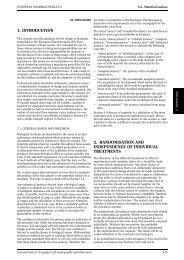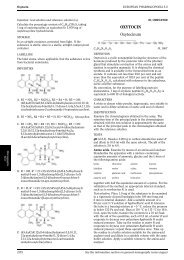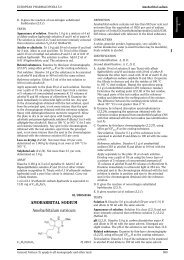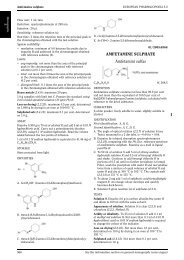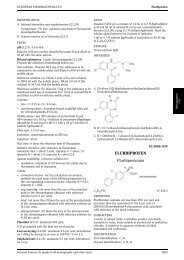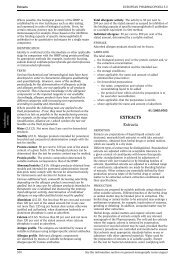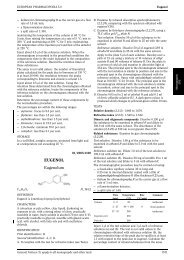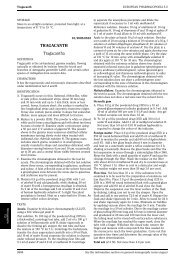ACARBOSE Acarbosum
ACARBOSE Acarbosum
ACARBOSE Acarbosum
You also want an ePaper? Increase the reach of your titles
YUMPU automatically turns print PDFs into web optimized ePapers that Google loves.
EUROPEAN PHARMACOPOEIA 5.1 Acarbose<br />
<strong>ACARBOSE</strong><br />
<strong>Acarbosum</strong><br />
04/2005:2089<br />
C25H43NO18 Mr 646<br />
DEFINITION<br />
O-4,6-Dideoxy-4-[[(1S,4R,5S,6S)-4,5,6-trihydroxy-3-<br />
(hydroxymethyl)cyclohex-2-enyl]amino]-α-D-glucopyranosyl-<br />
(1→4)-O-α-D-glucopyranosyl-(1→4)-D-glucopyranose, which<br />
is produced by certain strains of Actinoplanes utahensis.<br />
Content: 95.0 per cent to 102.0 per cent (anhydrous<br />
substance).<br />
CHARACTERS<br />
Appearance: white or yellowish, amorphous powder,<br />
hygroscopic.<br />
Solubility: very soluble in water, soluble in methanol,<br />
practically insoluble in methylene chloride.<br />
IDENTIFICATION<br />
A. Infrared absorption spectrophotometry (2.2.24).<br />
Comparison: acarbose for identification CRS.<br />
B. Examine the chromatograms obtained in the assay.<br />
Results: the principal peak in the chromatogram obtained<br />
with the test solution is similar in retention time and size<br />
to the principal peak in the chromatogram obtained with<br />
reference solution (a).<br />
TESTS<br />
Solution S. Dissolve 1.00 g in carbon dioxide-free water R<br />
and dilute to 20.0 ml with the same solvent.<br />
pH (2.2.3): 5.5to7.5forsolutionS. Specific optical rotation (2.2.7):+168to+183(anhydrous<br />
substance).<br />
Dilute 2.0 ml of solution S to 10.0 ml with water R.<br />
Absorbance (2.2.25): maximum 0.15 at 425 nm for<br />
solution S.<br />
Related substances. Liquid chromatography (2.2.29).<br />
Test solution. Dissolve 0.200 g of the substance to be<br />
examined in water R and dilute to 10.0 ml with the same<br />
solvent.<br />
Reference solution (a). Dissolve the contents of a vial of<br />
acarbose CRS in 5.0 ml of water R.<br />
Reference solution (b). Dissolve20mgofacarbose for peak<br />
identification CRS (acarbose containing impurities A, B, C,<br />
D, E, F, G and H) in 1 ml of water R.<br />
Reference solution (c). Dilute1.0mlofthetestsolutionto<br />
100.0 ml with water R.<br />
Column:<br />
— size: l =0.25m,Ø=4mm,<br />
— stationary phase: aminopropylsilyl silica gel for<br />
chromatography R (5 µm),<br />
— temperature: 35°C.<br />
Mobile phase: mix 750 volumes of acetonitrile R1 and<br />
250 volumes of a solution containing 0.60 g/l of potassium<br />
dihydrogen phosphate R and 0.35 g/l of disodium hydrogen<br />
phosphate dihydrate R.<br />
Flow rate: 2.0ml/min.<br />
Detection: spectrophotometer at 210 nm.<br />
Injection: 10 µl of the test solution and reference<br />
solutions (b) and (c).<br />
Run time: 2.5 times the retention time of acarbose.<br />
Identification of impurities: use the chromatogram<br />
supplied with acarbose for peak identification CRS and<br />
the chromatogram obtained with reference solution (b) to<br />
identifythepeaksduetoimpuritiesA,B,C,D,E,F,GandH.<br />
Relative retention with reference to acarbose (retention<br />
time = about 16 min): impurity D = about 0.5;<br />
impurity H = about 0.6; impurity B = about 0.8;<br />
impurity A = about 0.9; impurity C = about 1.2;<br />
impurity E = about 1.7; impurity F = about 1.9;<br />
impurity G = about 2.2.<br />
System suitability: reference solution (b):<br />
— peak-to-valley ratio: minimum 1.2, where H p =height<br />
above the baseline of the peak due to impurity A and<br />
H v = height above the baseline of the lowest point of the<br />
curve separating this peak from the peak due to acarbose,<br />
— the chromatogram obtained is similar to the<br />
chromatogram supplied with acarbose for peak<br />
identification CRS.<br />
Limits:<br />
— correction factors: for the calculation of contents,<br />
multiply the peak areas of the following impurities by<br />
the corresponding correction factor: impurity B = 0.63;<br />
impurity D = 0.75; impurity E = 1.25; impurity F = 1.25;<br />
impurity G = 1.25;<br />
— impurity A: not more than 0.6 times the area of the<br />
principal peak in the chromatogram obtained with<br />
reference solution (c) (0.6 per cent);<br />
— impurity B: not more than 0.5 times the area of the<br />
principal peak in the chromatogram obtained with<br />
reference solution (c) (0.5 per cent);<br />
— impurity C: not more than 1.5 times the area of the<br />
principal peak in the chromatogram obtained with<br />
reference solution (c) (1.5 per cent);<br />
— impurity D: not more than the area of the principal peak<br />
in the chromatogram obtained with reference solution (c)<br />
(1.0 per cent);<br />
— impurity E: not more than 0.2 times the area of the<br />
principal peak in the chromatogram obtained with<br />
reference solution (c) (0.2 per cent);<br />
— impurities F, G: for each impurity, not more than 0.3 times<br />
the area of the principal peak in the chromatogram<br />
obtained with reference solution (c) (0.3 per cent);<br />
— impurity H: not more than 0.2 times the area of the<br />
principal peak in the chromatogram obtained with<br />
reference solution (c) (0.2 per cent);<br />
— any other impurities: for each impurity, not more<br />
than 0.2 times the area of the principal peak in the<br />
chromatogram obtained with reference solution (c)<br />
(0.2 per cent);<br />
— total: not more than 3 times the area of the principal peak<br />
in the chromatogram obtained with reference solution (c)<br />
(3.0 per cent);<br />
— disregard limit: 0.1 times the area of the principal peak<br />
in the chromatogram obtained with reference solution (c)<br />
(0.1 per cent).<br />
GeneralNotices(1)applytoallmonographsandothertexts 2873
Acarbose EUROPEAN PHARMACOPOEIA 5.1<br />
Heavy metals (2.4.8): maximum 20 ppm.<br />
Dissolve 1.5 g in water R and dilute to 15 ml with the same<br />
solvent. If the solution is not clear, carry out prefiltration<br />
and use the filtrate. 10 ml complies with limit test E. Prepare<br />
the reference solution using 20 ml of lead standard solution<br />
(1 ppm Pb) R.<br />
Water (2.5.12): maximum 4.0 per cent, determined on<br />
0.300 g.<br />
Sulphated ash (2.4.14): maximum 0.2 per cent, determined<br />
on 1.0 g.<br />
ASSAY<br />
Liquid chromatography (2.2.29) as described in the test for<br />
related substances with the following modification.<br />
Injection: test solution and reference solution (a).<br />
Calculate the percentage content of C 25H 43NO 18 from the<br />
areas of the peaks and the declared content of acarbose CRS.<br />
STORAGE<br />
In an airtight container.<br />
IMPURITIES<br />
Specified impurities: A, B, C, D, E, F, G, H.<br />
A. O-4,6-dideoxy-4-[[(1S,4R,5S,6S)-4,5,6-trihydroxy-<br />
3-(hydroxymethyl)cyclohex-2-enyl]amino]-α-Dglucopyranosyl-(1→4)-O-α-D-glucopyranosyl-(1→4)-Darabino-hex-2-ulopyranose,<br />
B. (1R,4R,5S,6R)-4,5,6-trihydroxy-2-(hydroxymethyl)cyclohex-2-enyl4-O-[4,6-dideoxy-4-[[(1S,4R,5S,6S)-4,5,6-trihydroxy-3-(hydroxymethyl)cyclohex-2-enyl]amino]-α-D-glucopyranosyl]-α-D-glucopyranoside,<br />
C. α-D-glucopyranosyl 4-O-[4,6-dideoxy-4-[[(1S,4R,5S,6S)-4,5,<br />
6-trihydroxy-3-(hydroxymethyl)cyclohex-2-enyl]amino]-α-Dglucopyranosyl]-α-D-glucopyranoside,<br />
D. 4-O-[4,6-dideoxy-4-[[(1S,4R,5S,6S)-4,5,6-trihydroxy-<br />
3-(hydroxymethyl)cyclohex-2-enyl]amino]-α-Dglucopyranosyl]-D-glucopyranose,<br />
E. O-4,6-dideoxy-4-[[(1S,4R,5S,6S)-4,5,6-trihydroxy-<br />
3-(hydroxymethyl)cyclohex-2-enyl]amino]-α-Dglucopyranosyl-(1→4)-O-α-D-glucopyranosyl-(1→4)-Oα-D-glucopyranosyl-(1→4)-D-arabino-hex-2-ulopyranose<br />
(4-O-α-acarbosyl-D-fructopyranose),<br />
F. O-4,6-dideoxy-4-[[(1S,4R,5S,6S)-4,5,6-trihydroxy-<br />
3-(hydroxymethyl)cyclohex-2-enyl]amino]-α-Dglucopyranosyl-(1→4)-O-α-D-glucopyranosyl-(1→4)-<br />
O-α-D-glucopyranosyl-(1→4)-D-glucopyranose<br />
(4-O-α-acarbosyl-D-glucopyranose),<br />
G. α-D-glucopyranosyl O-4,6-dideoxy-4-[[(1S,4R,5S,6S)-4,5,6trihydroxy-3-(hydroxymethyl)cyclohex-2-enyl]amino]-α-Dglucopyranosyl-(1→4)-O-α-D-glucopyranosyl-(1→4)-O-α-Dglucopyranoside<br />
(α-D-glucopyranosyl α-acarboside),<br />
H. O-4,6-dideoxy-4-[[(1S,4R,5S,6S)-4,5,6-trihydroxy-<br />
3-(hydroxymethyl)cyclohex-2-enyl]amino]-α-Dglucopyranosyl-(1→4)-O-6-deoxy-α-D-glucopyranosyl-<br />
(1→4)-D-glucopyranose.<br />
2874 See the information section on general monographs (cover pages)



